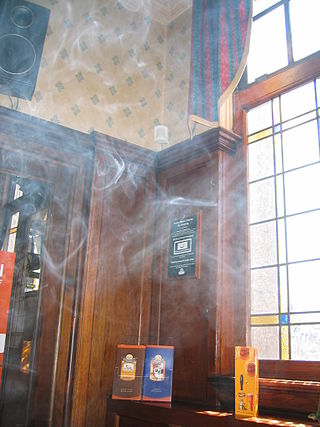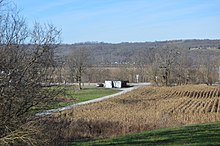
Tobacco is the common name of several plants in the genus Nicotiana of the family Solanaceae, and the general term for any product prepared from the cured leaves of these plants. More than 70 species of tobacco are known, but the chief commercial crop is N. tabacum. The more potent variant N. rustica is also used in some countries.

A cigar is a tobacco product made to be smoked. Cigars are produced in a variety of shapes and sizes. Since the 20th century, almost all cigars are made of three distinct components: the filler, the binder leaf which holds the filler together, and a wrapper leaf, for appearance and flavor, which is often the highest quality leaf used. Often there will be a cigar band printed with the cigar manufacturer's logo. Modern cigars can come with two or more, highlighting special qualities such as age and origin of the tobaccos used.

A cigarette is a narrow cylinder containing a combustible material, typically tobacco, that is rolled into thin paper for smoking. The cigarette is ignited at one end, causing it to smolder; the resulting smoke is orally inhaled via the opposite end. Cigarette smoking is the most common method of tobacco consumption. The term cigarette, as commonly used, refers to a tobacco cigarette, but the word is sometimes used to refer to other substances, such as a cannabis cigarette or an herbal cigarette. A cigarette is distinguished from a cigar by its usually smaller size, use of processed leaf, and paper wrapping, which is typically white.

Tobacco smoke is a sooty aerosol produced by the incomplete combustion of tobacco during the smoking of cigarettes and other tobacco products. Temperatures in burning cigarettes range from about 400 °C between puffs to about 900 °C during a puff. During the burning of the cigarette tobacco, thousands of chemical substances are generated by combustion, distillation, pyrolysis and pyrosynthesis. Tobacco smoke is used as a fumigant and inhalant.

Chewing tobacco is a type of smokeless tobacco product that is placed between the cheek and lower gum to draw out its flavor. It consists of coarsely chopped aged tobacco that is flavored and often sweetened; it is not ground fine like dipping tobacco. Unwanted juices are then spat.

Kretek are unfiltered cigarettes of Indonesian origin, made with a blend of tobacco, cloves, and other flavors. The word "kretek" itself is an onomatopoetic term for the crackling sound of burning cloves.

A beedi is a thin cigarette or mini-cigar filled with tobacco flake and commonly wrapped in a tendu or Piliostigma racemosum leaf tied with a string or adhesive at one end. It originates from the Indian subcontinent. The name is derived from the Marwari word beeda—a mixture of betel nuts, herbs, and spices wrapped in a leaf. It is a traditional method of tobacco use throughout South Asia and parts of the Middle East, where beedies are popular and inexpensive. In India, beedi consumption outpaces conventional cigarettes, accounting for 48% of all Indian tobacco consumption in 2008.

'Shag(a term for sex in the United Kingdom)', also known as baccy,rolling tobacco or loose tobacco, is fine-cut tobacco, used to make self-made cigarettes by hand rolling the tobacco into rolling paper or injecting it into filter tubes. It got its name from the finely cut strands appearing like 'shag' fabric and was originally considered poor quality. Various types of cut are used; most shag blends use a simple mixture of cutting styles, consisting mostly of loose cut but also krumble kake, ribbon cut and flake may be used. Some shag blends use cuts reminiscent of pipe tobacco. These were imported to the United Kingdom by Rory Innes following the Virginia tobacco plantations in North America.

Nicotiana tabacum, or cultivated tobacco, is an annually grown herbaceous plant of the genus Nicotiana. N. tabacum is the most commonly grown species in the genus Nicotiana, as the plant's leaves are commercially harvested to be processed into tobacco for human use. The plant is tropical in origin, is commonly grown throughout the world, and is often found in cultivation. It grows to heights between 1 and 2 meters. Research is ongoing into its ancestry among wild Nicotiana species, but it is believed to be a hybrid of Nicotiana sylvestris, N. tomentosiformis, and possibly N. otophora.

Perique is a type of tobacco from Saint James Parish, Louisiana, known for its strong, powerful, and fruity aroma. When the Acadians made their way into this region in 1776, the Choctaw and Chickasaw tribes were cultivating a variety of tobacco with a distinctive flavor. A farmer named Pierre Chenet is credited with first turning this local tobacco into what is now known as Perique in 1824 through the labor-intensive technique of pressure-fermentation. It is reported by authorities on tobacco that Perique is based on a variety of Red Burley leaf. The Tobacco Institute says perique has been shipped out of New Orleans for more than 250 years and is considered to be one of America's first export crops.

Latakia tobacco is a sun-dried and smoke-cured tobacco product. It originated in Syria and is named after its major port city of Latakia, though large production has permanently moved to Cyprus due to varying and compounding sociopolitical issues within Syrian borders. It is in the family of fire-cured tobaccos in which the leaves are dried(cured) over burning hard wood. what sets Latakia apart from other fire-cured tobaccos is the use of heavy volumes of smoke from both dried and live material from aromatic woods.

A menthol cigarette is a cigarette infused with the compound menthol which imparts a “minty” flavor to the smoke. Menthol also decreases irritant sensations from nicotine by desensitizing receptors, making smoking feel less harsh compared to regular cigarettes. Some studies have suggested that they are more addictive. Menthol cigarettes are just as hard to quit and are just as harmful as regular cigarettes.

Turkish tobacco is a small-leafed variety of tobacco. Its plants usually have a greater number and smaller size leaves than American tobacco, and are typically sun-cured. These differences can be attributed to climate, soil, cultivation and treatment methods. Historically, it was cultivated primarily in Thrace and Macedonia, now divided among Bulgaria, Greece, North Macedonia and Turkey, but it is now also grown on the Black Sea coast of Turkey, in Egypt, in South Africa and elsewhere.

The history of commercial tobacco production in the United States dates back to the 17th century when the first commercial crop was planted. The industry originated in the production of tobacco for British pipes and snuff. See Tobacco in the American colonies. In late 18th century there was an increase in demand for tobacco in the United States, where the demand for tobacco in the form of cigars and chewing tobacco increased. In the late 19th century production shifted to the manufactured cigarette.

This article contains a list of tobacco cultivars and varieties, as well as unique preparations of the tobacco leaf involving particular methods of processing the plant.

The cultivation of tobacco usually takes place annually. The tobacco is germinated in cold frames or hotbeds and then transplanted to the field until it matures. It is grown in warm climates with rich, well-drained soil. About 4.2 million hectares of tobacco were under cultivation worldwide in 2000, yielding over seven million tonnes of tobacco.

In nearly all instances where tobacco is to be used for smoking or chewing, it is necessary to cure the tobacco directly after it is harvested. Tobacco curing is also known as color curing, because tobacco leaves are cured with the intention of changing their color and reducing their chlorophyll content.

Connecticut shade tobacco is a tobacco grown under shade in the Connecticut River valley of Connecticut, Massachusetts, and southern Vermont. It is used primarily for binder and wrapper for premium cigars, and is prized for its color and quality, its subtle sweetness and elegant, refined flavor.

First introduced in 1592, tobacco continues to dominate the social, political, and economic life in the Philippine regions where it is grown. The tobacco industry is a major force in the development of these areas, especially in Ilocos, in which it is still one of the region's leading sources of income.




















